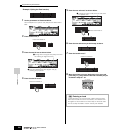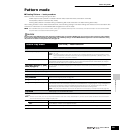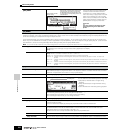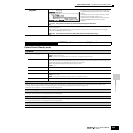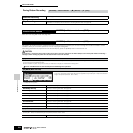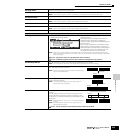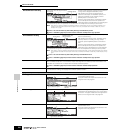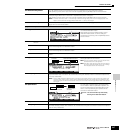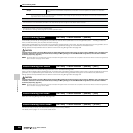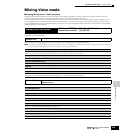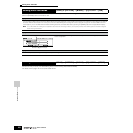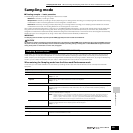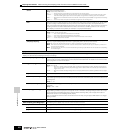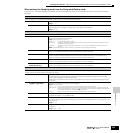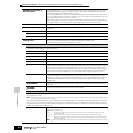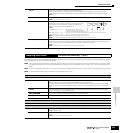
Reference Pattern Mode
Pattern Mixing mode
248
Owner’s Manual
In this mode, you can set up mixing data for your patterns, and set various parameters for the tone generator parts — including the desired
Voice, as well as its level, pan, EQ, effect and other settings.
Pattern Mixing parameters are not actually part of the Pattern sequence data in each track, but rather are settings for the tone generator, as it is
played back by the Pattern data. As such, the Pattern Mixing parameter settings are not recorded to the Pattern tracks.
Mixing operations and parameters are the same as those of the Song Mixing mode. See page 236.
Parameter settings made in the Pattern Mixing mode and Pattern Mixing Edit mode should be stored to internal memory (DRAM) as part of the Pattern data.
In addition, make sure to save the entire Pattern data (including the Mixing settings) to the SmartMedia/USB storage device, since the data in DRAM is
stored only temporarily (page 187).
n Parameter settings in the Pattern Mixing mode and Pattern Mixing Edit mode can be stored as a template to internal Flash ROM, as well as being stored as
part of a Pattern. See page 104 for details.
This mode provides more detailed Mixing parameters than in the Pattern Mixing mode.
Keep in mind that Pattern Mixing parameters are not actually part of the Pattern sequence data in each track, but rather are settings for the tone
generator, as it is played back by the Pattern data. As such, the Pattern Mixing parameter settings are not recorded to the pattern tracks.
Mixing operations and parameters are the same as those of the Song Mixing mode. See page 234.
Parameter settings made in the Pattern Mixing mode and Pattern Mixing Edit mode should be stored to internal memory (DRAM) as part of the Pattern data.
In addition, make sure to save the entire Pattern data (including the Mixing settings) to the SmartMedia/USB storage device, since the data in DRAM is
stored only temporarily (page 187).
n Parameter settings in the Pattern Mixing mode and Pattern Mixing Edit mode can be stored as a template to internal Flash ROM, as well as being stored as
part of a Pattern. See page 104 for details.
Same as in the Song Mixing Job mode. See page 236.
This function lets you store your edited Pattern Mixing to User memory (DRAM).
For details, refer to page 131 in the Quick Guide section.
Sample When this box is checkmarked, Sample Voices (if included in the source pattern) are copied to the destination
Pattern.
n When the KEEP ORIGINAL PHRASE checkbox is checked, this Job requires twice the number of empty user phrases as the number of tracks containing data in which to
store the appended phrase data. If the required space is unavailable, an alert message will appear and the job will be aborted. If this occurs use the Clear Phrase Job
(page 246) to delete unused phrases and try again.
04: Clear Pattern
This Job deletes all data from the selected Pattern, or from all Patterns. When the specific section is selected to be cleared, you can unmark the Chain box.
If the Chain box is not checkmarked, the Pattern Chain data will be kept even though the Clear Pattern Job is executed.
05: Pattern Name
This Job lets you assign a name to the selected Pattern.
For instructions on naming, refer to page 53 in the Basic Operation section.
Pattern Mixing mode
[PATTERN] → Pattern selection → [MIXING]
Pattern Mixing Edit mode
[PATTERN] → Pattern selection → [MIXING] → [EDIT]
Pattern Mixing Job mode
[PATTERN] → Pattern selection → [MIXING] → [JOB]
Pattern Mixing Store mode
[PATTERN] → Pattern selection → [MIXING] → [STORE]
CAUTION
CAUTION



